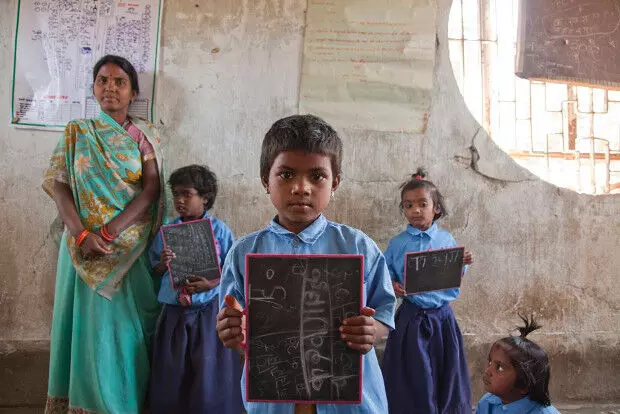More Poor Children in School, 30% Suffer Malnutrition

- 97% of 12-year-olds were enrolled in elementary schools in 2013; up from 89% in 2006.
- Almost a third of children continue to show signs of malnutrition at age 12 with high rates for economically- and socially-marginalised children and those in rural areas.
- 49% of older children were still in school at the age of 19; 9% had yet to complete secondary education, 8% had moved on to vocational or post-secondary education and a third had started university.
| Percentage of 12-year-olds attending school | ||||||
|---|---|---|---|---|---|---|
| Year | Gender | Child's ethnic group or caste | ||||
| Male | Female | Scheduled castes | Scheduled tribes | Backward class | Other castes | |
| 2006 | 91.2 | 87.3 | 85.3 | 86.8 | 88.4 | 96.1 |
| 2013 | 97.3 | 96.6 | 97.2 | 96.1 | 96.4 | 98.7 |
Source: Young Lives study
The Young Lives study also found that there has been considerable progress in addressing inequalities in school enrolment in the past few years, especially the gender gap—where enrolment of boys and girls was almost equal compared to a difference of 4 percentage points in 2006. However, inequalities related to segregation of the poorest children into government schools and the dip in learning levels across both private and government schools continue. There are worrying signs with the study revealing a fall in learning standards since 2006, with only half the children able to answer maths questions correctly, compared with two-thirds of children in 2006. Nutrition and Health Stunting in children due to malnourishment has not changed much—there was an improvement of only 4 percentage points in 8 years, according to data in the Young Lives study.| Health Indicators and Access to Water and Sanitation | ||||
|---|---|---|---|---|
| Year | Percentage of 12-year-olds stunted | Percentage of universal access to clean water | Percentage of children with access to sanitation | |
| Urban | Rural | |||
| 2006 | 34 | 84 | 92 | 16 |
| 2013 | 30 | 99 | 93 | 21 |
Source: Young Lives study
Socially-marginalised groups and the poorest households need to be targeted in efforts to reduce malnutrition, according to this study with more than a third of scheduled caste, scheduled tribe and other backward caste children being thin compared to a quarter of children from other castes. IndiaSpend has also reported how malnourishment is turning out to be fatal for children across the country; about 56 out of 1,000 kids under the age of five died in India in 2012 due to malnutrition, according to the Global Nutrition Report. Youth and Development The study has reported how children from economically- and socially-disadvantaged backgrounds were the most likely to have left school, many without gaining a secondary-level certificate.| Percentage of 19-year-olds | |||||
|---|---|---|---|---|---|
| Gender | Only studying | Only working | Studying+working | Married, not studying or working | Not studying working or married |
| Male | 34 | 40 | 23 | 0 | 3 |
| Female | 34 | 32 | 8 | 17 | 10 |
Source: Young Lives study
51.5% of the total cohort of 19-year-olds had left school, with only 15.8% achieving secondary education. Many young people from marginalised groups had already started full-time work, mostly self-employed or wage-employed in agriculture, with no further education or vocational skills. IndiaSpend’s earlier reports have shown how youth are affected by lower levels of education and skills.| Percentage of married 19-year-olds | ||||||
|---|---|---|---|---|---|---|
| Place of residence | Terciles/thirds of wealth index | |||||
| Urban | Rural | Top third | Bottom third | |||
| 14 | 21 | 12 | 23 | |||
Source: Young Lives study
While 36% of girls were married by the age of 19, according to the study, only 2% of boys were married at that age. Despite the legal age for marriage being 18, 37% of girls were married by 19 (an average age of 16.6 years, below the legal age). And 108 of them, from the selected cohort, already have a child of their own (almost two-thirds of the married girls). Education and maternal health is adversely affected if girls marry early.Young Lives is following the lives of 3,000 children and young people and their families living in 20 communities in six districts in Andhra Pradesh and Telangana.
The children in the study come from two age groups: 2,000 children born in 2001-02 (the younger cohort) and 1,000 children born in 1994-95 (the older cohort). The entire sample is a pro-poor sample—consisting of children from poor families.
The longitudinal nature of the study (ie. extending over a long period of time) provides opportunities to gain insights into transitions across various phases of childhood.
In the case of the older cohort, the round 4 survey (2013-14) even provides insights into their transition into adulthood when some became parents themselves.
Parallel studies were held in Ethiopia, Peru and Vietnam with 3,000 children/households by Young Lives.
These four countries, including India, were chosen for their cultural and socio-economic diversity.
The core objective of the Young Lives study is to examine the causes and consequences of childhood poverty in order to build better social policy alternatives for these children.
While the final report of this study is still awaited, preliminary data have shown mixed results in improvement of socio-economic welfare of children in the sample from India.


